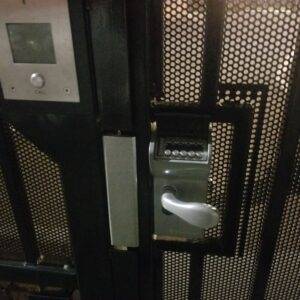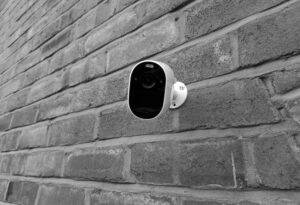An intercom is a communication device that allows people in different locations to talk to each other, almost like a two-way radio built into a building or a specific area. It’s designed to make communication easier, especially when direct face-to-face interaction might not be possible or convenient.
Imagine you’re in one room of a building, and your friend is in another room or even in a different part of the building. Instead of walking over to where your friend is, you can use the intercom to speak to them as if you were right next to each other. It’s like having a virtual conversation without having to physically move.
Typically, an intercom system consists of at least two parts: a speaker and a microphone. The speaker is placed in one location, and the  microphone is placed in another. When you talk into the microphone, your voice is transmitted through the system and emerges from the speaker at the other end. This way, both parties can hear each other’s voices and have a conversation, even if they’re separated by walls or distance.
microphone is placed in another. When you talk into the microphone, your voice is transmitted through the system and emerges from the speaker at the other end. This way, both parties can hear each other’s voices and have a conversation, even if they’re separated by walls or distance.
Intercoms are commonly used in various settings such as office buildings, schools, hospitals, apartment complexes, and even some homes. They serve as a convenient way to communicate announcements, ask for assistance, or just have a quick conversation without needing to physically move from one place to another.
In more advanced intercom systems, you might also find additional features such as video cameras, allowing people to see each other. At the same time they talk, and integration with other technologies like smartphones or computers, making communication even more versatile and accessible. Intercom systems are used for a variety of reasons, but their main purpose is to facilitate communication in situations where direct face-to-face interaction might be impractical or inconvenient. Here are some of the main reasons why people would use intercom systems, intercoms make communication quick and easy, especially when people are in different parts of a building or facility. Instead of physically walking to someone’s location, you can communicate instantly through the intercom.
In reference to security needs, intercoms are commonly used to allow people to communicate with visitors before granting them access to a building or a gated community. This helps verify the identity of the person requesting entry and enhances overall security.
In public spaces like schools, offices, and hospitals, intercoms are used to make announcements to a large group of people simultaneously. This could include important announcements, emergency alerts, or general information. Intercom systems are essential during emergencies. They allow authorities or security personnel to broadcast critical information quickly, such as evacuation instructions, lockdown procedures, or safety alerts.
In some cases, intercoms provide a way to communicate without needing to be physically close to someone. For instance, in a medical setting, doctors and nurses might use intercoms to communicate with patients without intruding on their personal space and in the workplaces like offices, factories, or warehouses, intercoms can improve productivity by enabling swift communication between different departments or areas. Employees can quickly discuss tasks, give instructions, or ask for help.
intercoms can improve productivity by enabling swift communication between different departments or areas. Employees can quickly discuss tasks, give instructions, or ask for help.
Intercoms integrated with door entry systems allow remote access control. This is especially useful in buildings with restricted entry. Residents or employees can communicate with visitors and remotely grant or deny them access while some households use intercom systems to communicate between different rooms, especially in larger homes. This can be convenient for calling family members to dinner or checking in without shouting across the house.
Modern intercom systems often come with the capability to be connected to smartphones, enabling users to answer the door remotely. This integration is commonly seen in smart doorbell systems. Here’s how it works:
- A smart doorbell is installed at the entrance of a building or home. It usually includes a camera, a microphone, a speaker, and sometimes motion sensors. When a visitor rings the doorbell or triggers the motion sensor, the camera captures a video feed, and the microphone allows for two-way audio communication.
- The smart doorbell system is paired with a mobile app on the user’s smartphone. This app allows the user to receive notifications when someone rings the doorbell or when motion is detected. The app also provides a live video feed from the camera and enables two-way audio communication with the visitor at the door.
- Remote Communication: When a visitor arrives at the door and rings the smart doorbell, the user receives a notification on their smartphone. They can then open the mobile app to see who is at the door through the live video feed. They can speak to the visitor using the two-way audio communication feature, even if they are not physically present at the door.
- In some cases, smart doorbell systems are integrated with smart locks or access control systems. This allows the user to remotely unlock the door for the visitor through the app, granting them access without needing to be present.
This integration offers several benefits:
- Users can communicate with visitors even when they are not at home, providing a level of security and convenience.
- The ability to see and communicate with visitors remotely adds to the security of the premises, as users can verify the identity of the person at the door before deciding to answer or grant access.
- Users can instruct delivery personnel on where to leave packages or provide access codes, ensuring secure package deliveries.
- The visible presence of a smart doorbell camera can act as a deterrent to potential intruders.
However, it’s important to consider potential downsides such as privacy concerns, reliance on stable internet connectivity, and potential technical issues. As technology continues to advance, these smart intercom systems are becoming more sophisticated, user-friendly, and integrated with home automation ecosystems.
